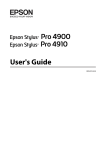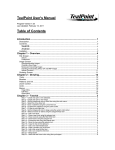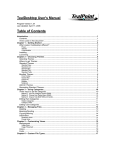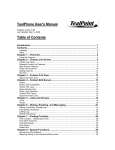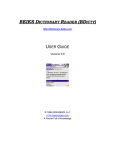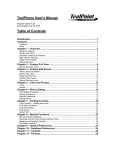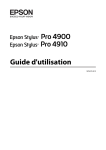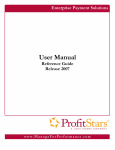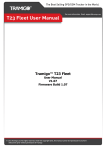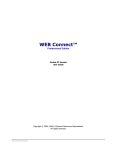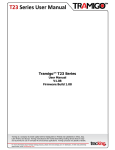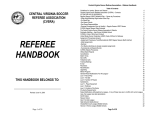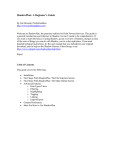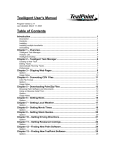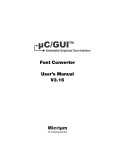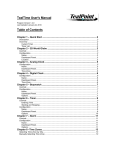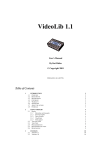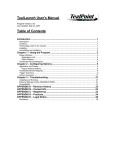Download TealDoc User`s Manual Table of Contents
Transcript
TealDoc User's Manual
Program Version 6.89
Last Updated: April 17, 2008
Table of Contents
Introduction .......................................................................................................................... 1
Contents ............................................................................................................................ 1
Installing ............................................................................................................................ 2
Terms used in this document............................................................................................... 3
Chapter 1 – Overview ........................................................................................................... 4
Document List .................................................................................................................... 4
Reading Screen ................................................................................................................. 4
Editing Screen.................................................................................................................... 4
Chapter 2 – Document List ................................................................................................... 5
Navigation.......................................................................................................................... 5
Device Selection........................................................................................................................................................5
Memory Selector..................................................................................................................................................5
External Card Selectors........................................................................................................................................5
Current Directory Path..........................................................................................................................................5
Parent Folder........................................................................................................................................................5
Root Folder...........................................................................................................................................................5
Opening and Editing Documents ......................................................................................... 6
Documents.................................................................................................................................................................6
Images .......................................................................................................................................................................6
Beaming and Sending Documents and Images .................................................................... 6
Moving and Deleting Documents and Images ....................................................................... 6
The TealPoint File Manager.......................................................................................................................................7
Deleting Files .............................................................................................................................................................7
Details (Information) ........................................................................................................... 8
Backup at HotSync...............................................................................................................................................8
Private ..................................................................................................................................................................8
Scanned for bookmarks........................................................................................................................................8
Format ..................................................................................................................................................................8
Category...............................................................................................................................................................8
Supporting Raw Text Files .................................................................................................. 9
Default Raw Text Types .......................................................................................................................................9
Adding New Raw Text Types ...............................................................................................................................9
Installing Raw Text Files.......................................................................................................................................9
Customizing the Document List ......................................................................................... 11
Chapter 3 – Reading Documents........................................................................................ 12
Display Area .................................................................................................................... 12
Scrolling Display .................................................................................................................................................12
Selecting Text.....................................................................................................................................................12
Back Button ..................................................................................................................... 13
Finding Text ..................................................................................................................... 13
Font Selection / Options ................................................................................................... 14
Screen Rotation ............................................................................................................... 15
Toggle ToolBar (Full Screen Mode) ................................................................................... 16
Bookmarks and Notes....................................................................................................... 16
Chapter 4 – Advanced Reading Tools ................................................................................ 19
Lookup Word.................................................................................................................... 19
AutoScroll ........................................................................................................................ 19
Printing Support ............................................................................................................... 19
Reading Colors ................................................................................................................ 20
Text ....................................................................................................................................................................20
Hi-text.................................................................................................................................................................20
Back ...................................................................................................................................................................20
Hi-back ...............................................................................................................................................................20
Link.....................................................................................................................................................................20
Hi-link .................................................................................................................................................................20
Header................................................................................................................................................................20
HRule .................................................................................................................................................................20
Drag1, Drag2......................................................................................................................................................20
Auto1, Auto2.......................................................................................................................................................20
Force 16-bit mode on open.................................................................................................................................20
Chapter 5 – Editing Documents.......................................................................................... 21
Creating a New Document ................................................................................................ 21
Importing from Memos/MemoPad ...................................................................................... 21
Editing ............................................................................................................................. 21
Cursor Movement ............................................................................................................. 22
Search and Replace ......................................................................................................... 22
Fonts ............................................................................................................................... 23
Word Lookup.................................................................................................................... 23
Exporting to Memos/MemoPad.......................................................................................... 23
Printing ............................................................................................................................ 23
Changing Capitalization .................................................................................................... 24
Word Count ...................................................................................................................... 24
Chapter 6 – Application Preferences.................................................................................. 25
Chapter 7 – Document List Preferences............................................................................. 26
Chapter 8 – Reading Preferences....................................................................................... 27
Chapter 9 – Reading Preferences....................................................................................... 29
Chapter 10 – Editing Preferences....................................................................................... 30
Chapter 11 – Special Topics ............................................................................................... 31
Palm 5-Way Control.......................................................................................................... 31
Full Screen Modes............................................................................................................ 31
Flash Rom Support ........................................................................................................... 31
Upgrading from other browsers ......................................................................................... 32
Security ........................................................................................................................... 32
Oversized Images ............................................................................................................ 32
Chapter 12 – Creating Document Files............................................................................... 33
In TealDoc ....................................................................................................................... 33
In TealDoc Maker ............................................................................................................. 33
Creating a Doc File ........................................................................................................... 34
Step 1) Select a Source Type..................................................................................................................................34
Step 2) Select a Source File ....................................................................................................................................34
Step 3) Select a Palm Name ....................................................................................................................................34
Step 4) Select Advanced Options ............................................................................................................................35
Step 5) Selection Document Protection Options ......................................................................................................35
Step 6) Start Conversion..........................................................................................................................................35
Unmaking Doc Files.......................................................................................................... 36
Third Party Utilities ........................................................................................................... 36
Converting Microsoft Word Docs ....................................................................................... 36
Converting HTML Web Files ............................................................................................. 36
Chapter 13 – Imbedding Graphics/Links/Headers .............................................................. 37
Tag Overview................................................................................................................... 37
Tag Placement ................................................................................................................. 37
Appendix A – TealDoc Tag Reference ................................................................................ 38
TEALPAINT ..................................................................................................................... 38
HRULE ............................................................................................................................ 40
LINK ................................................................................................................................ 41
HEADER ......................................................................................................................... 43
BOOKMARK .................................................................................................................... 44
LABEL ............................................................................................................................. 44
Appendix B – TealPoint File List ......................................................................................... 45
2
File Lists .......................................................................................................................... 45
Navigation........................................................................................................................ 45
Categories ....................................................................................................................... 46
Flash Memory .................................................................................................................. 46
Appendix C – TealPoint File Manager................................................................................. 47
Moving/Copying Files ....................................................................................................... 47
Appendix D – TealPoint Button Manager............................................................................ 48
Description....................................................................................................................... 48
Changing Default Mappings .............................................................................................. 48
Creating New Mappings .................................................................................................... 48
Appendix E – TealPoint Pen-Free Navigation ..................................................................... 49
Appendix F – Products....................................................................................................... 50
Appendix G – Revision History........................................................................................... 53
Appendix H – Contact Info.................................................................................................. 54
Appendix I – Registering .................................................................................................... 55
Appendix J – Legal Notice .................................................................................................. 55
3
Introduction
Thank you for trying TealDoc. A powerful yet intuitive reader and editor for standard PalmPilot
document (“Doc”) and text files, TealDoc offers advanced functionality such as:
•
•
•
•
•
•
•
•
•
•
•
•
•
editing
printing
search and replace
bookmarks
automatic scrolling
imbedded images
rotate-able display
antialiased fonts
smooth scrolling
full view mode
tiny font
external application calling
document linking.
Contents
This archive contains the following files:
Program files:
TEALDOC.PRC
TDOCMAKE.EXE
FONTBUCKET.PRC
TPSETUP.EXE
The TealDoc program file
TealDoc document creation/install utility (Windows)
FontBucket add-on font manager
Windows easy-installer program
FBFONTS.PDB
DEMODOC.PDB
DEMOIM.PDB
Optional set of add-on fonts
Sample Palm document demonstrating features
Image data for sample document
DOCDOC.PDF
DOCDOC.HTM
DOCDOC.PRC
DOCDOC.SRC
REGISTER.HTM
REGISTER.TXT
This document in Adobe Acrobat (PDF) format
This document in HTML format (sans images)
This document in TealDoc format
Example text source file to the manual doc
TealPoint Registration form in HTML format
TealPoint Registration form in text format
Content files:
Document files:
1
Installing
On a Windows PC you can also use quick setup installer by double clicking on the
TPSETUP.EXE installer program, and following the on screen prompts.
For other systems:
1) Install Program
Use the Palm Install Tool that comes with your organizer to install the program file
TEALDOC.PRC. The Palm Install Tool can be found as an icon along the
left hand side inside the Palm Desktop program on your desktop computer.
Instructions on how to use the Palm install tool are in the Palm Handbook or
electronic manual that came with your Pilot, PalmPilot, Visor, CLIE, or
WorkPad.
2) Install Fonts
Install FONTBUCKET.PRC if you wish to support add-on fonts, and FBFONTS.PDB for
our own selection of fonts we’ve hand-optimized for use with TealDoc. Visit HandsHigh
Software for additional fonts or tools to convert your own fonts from your Mac or PC
desktop.
3) Install Documents
For it to be useful, you’ll also need to install some document files, available on our web
site or most software archive sites like MemoWare.com. Two sample documents come in
this archive. First, a portable version of this manual is included as the PalmPilot
document DOCDOC.PRC. A sample document DemoDoc is also provided. It
demonstrates the image, link, and advanced capabilities in TealDoc. To view it, install
both the document file DEMODOC.PDB and the accompanying image file
DEMOIM.PDB.
2
Terms used in this document
Hardware Buttons:
The four physical buttons (e.g. date, address, todo, and memo) typically located in a row
at the bottom of your handheld
Scroll Up/Down Buttons:
The physical rocker switch at the bottom center of the handheld
Five-way control:
On newer handhelds, a 5-way control replaces the scroll up/down buttons, adding left
and right movement and a center select button.
Graffiti:
The special letter-like symbols you write to enter text with your stylus.
Graffiti Entry Area:
The rectangular area at the bottom of the display screen where you can write letters in
graffiti.
Silkscreen Buttons:
The four printed circular tap areas (Home, Menu, Calculator, and Find) to the left and
right of the graffiti drawing area.
Menus:
The drop-down menus you get when tapping on the silkscreen menu button, or tap on the
title bar (if present) on a device running PalmOS 3.5 or higher.
3
Chapter 1 – Overview
Start TealDoc by tapping it is icon in your application launcher screen. TealDoc is
easy to use, and consists of three basic interface screens.
Document List
The first screen, the Document List, appears when you first run the
program. Shown is a list of all doc files currently installed on the
handheld under the active category or in the current location on an
external storage card.
From this screen, you can move or manipulate documents, or open
them for viewing or editing.
Reading Screen
When you open a document, you are brought to the Reading
Screen, which displays the text with full formatting images, and
links. A full selection of features, fonts and tools are available,
including display rotation, high resolution fonts, bookmarks, notes,
and a full screen mode.
Editing Screen
The Editing Screen lets you compose a document or modify the
contents of an existing one. Documents are shown in raw text using
standard PalmOS text controls, and can be manipulated with cut,
copy, and paste commands and even a search and replace option.
4
Chapter 2 – Document List
Documents are listed on the main TealDoc page in a TealPoint
Standard File List (See Appendix). TealDoc supports documents in
standard PalmPilot “Doc” format, enhanced “TealDoc” format, or raw
text files.
Proprietary formats, such as Peanut Press (Protected PalmReader
format), iSilo, are not supported, and documents in those formats
will not appear in the document list.
Navigation
The document list shows files in the current location in the current category. Tap on the
category pick list in the upper right hand corner of the screen to change categories.
The file size in bytes of kilobytes (k) is shown to the right of each document, and non-writable
files in ROM (or those with their PalmOS “readonly” property set) are listed with a dot next to
their names.
Device Selection
If an external Virtual File System (VFS) –compatible expansion device is detected, a row
of icons will appear at the top of the screen to allow you to select a device or navigate
folder. From left to right, these are:
Memory Selector
Shaped like a memory chip, the memory selector shows files present in main organizer
memory
External Card Selectors
Shaped like a memory card, the external card selectors show files present in external
memory cards and devices. Up to four external memory cards, if supported by hardware,
may be present.
Current Directory Path
When an external device is selected, the location of the current directory is shown in the
center top of the screen. The location is shown as a “path”, or the sequence of folders
traversed to reach the current location from the start “root” location of the card.
Parent Folder
Selecting the Parent Folder icon moves the current folder back up one level to the folder
which contains the current folder. The starting “root” folder has no parent folder.
Root Folder
Shaped like a house, the Root Folder sets the current folder location to the “root” or
“home” directory of the card.
5
Opening and Editing Documents
Documents
To open a document for reading or editing, simply tap on its name with the “open” or
“edit” pushbutton highlighted.
Images
TealDoc documents can optionally show images from TealPaint-format image databases.
While the document list normally shows the documents present on your Palm, you can
also use it to display and manage the list of TealPaint -format databases that are
installed. To see the list of image databases, change the popup list in the upper right
from “Docs” to ”Pics”.
When the viewing mode is set to “Pics”, tapping on a name with “open” or “edit” selected
will open the picture in TealPaint if TealPaint is installed, but will have no effect
otherwise.
Beaming and Sending Documents and Images
Select the “send” pushbutton and tap on the document to
beam or send it.
You will be asked to either send or beam the document. When
you beam a document, TealDoc uses the infrared port on the
handheld to transmit it to another device. When you use the
send option, TealDoc allows you to use Bluetooth, SMS, or a
similar mechanism, depending on hardware the system
software on your handheld.
When you beam a document to another Palm, that Palm will
also need a document reader to read the file. You can beam an evaluation copy of TealDoc
to another Palm by using the Beam menu item in the standard PalmOS launcher screen. See
your organizer’s documentation for more information on beaming applications.
Moving and Deleting Documents and Images
TealDoc supports the TealPoint standard File Manager for copying
or moving files. To open the manager, tap on the Mov pushbutton
and tap on the name of the file to move or copy.
See the Appendix for more information on using its interface.
6
The TealPoint File Manager
The TealPoint Standard File Manager allows you to copy or move the pre-selected file
from one folder or device to another. The contents of a target location to receive the file
appear in the lower half of the screen. Simply select the destination device and folder
using the file list and device/navigation icons, and tap on the Copy or Move buttons to
start. Files may be copied between RAM and external storage cards, or between folders
on the same storage card. The target location must differ from where the source file
already exists. Note that items in the list are not selectable, but are present to indicate
contents which may already be present in the target location for the pre-selected file.
Note that operations are limited to what is supported by the installed hardware and
system software.
Palm Memory
PalmOS memory does not support folders, and can normally only hold PalmOSspecific resource (.PRC) and database (.PDB) files. When copying desktopspecific files such as .TXT text files, the TealPoint File Manager automatically
wraps these in a .PDB file header following the TealPoint “Public” file format so
they can be stored in main memory too.
MemPlug
The system software MemPlug expansion Springboard modules does not
support the VFS-standard interface for moving of files between Cards and RAM,
but third-party add-ons such as the Kopsis Engineering VFS library can add this
capability.
Sony CLIE
Sony CLIE handhelds running older versions of the PalmOS system software
(prior to PalmOS 4.0) do not support copying files to any folders outside the root
standard “MSSONY” folder. Subfolders can be freely made and used within the
MSSONY folder however.
An additional Folder button is present for creating and deleting folders. If the current
target is on a device which supports folders, tap on it to either delete the current folder
location (if it is empty) or create a new subfolder in the current target location.
Deleting Files
Do not use the Palm Application launcher to delete documents, as the Palm OS groups
files together under a single heading, and you can end up deleting all of your documents
at once instead of the single one listed. Use the provided interface in the TealDoc
Document List instead.
7
Details (Information)
Document Details displays and modifies global properties of a
Doc-format document. Open it by selecting the “Info”
pushbutton and tapping on a document name. It has no effect
on text-format documents, however, as they cannot store the
extra information.
Backup at HotSync
Instructs the PalmOS default HotSync conduit to back up a file in main memory when
modified
Private
If marked, this file will be hidden or masked on the Document List depending on the global
Security private record state.
Scanned for bookmarks
When checked, this document has already been scanned for bookmarks and will not
automatically be (re)scanned when opened. This choice only appears when the details
window is opened from within the Reading or Editing screens.
Format
Determines whether Doc format files are flagged to be “owned” by TealDoc or in “public”
format. Public format files will be accessible to other applications and may be listed by
themselves in the application launcher “delete” screen (depending on OS version), while
“TealDoc” format documents will be listed under a TealDoc heading.
Category
Sets the category for the document as seen on the Document List.
8
Supporting Raw Text Files
While TealDoc automatically recognizes standard Doc files and
TealDoc files, you can also install raw text files to an external
expansion card under OS 4.0 and view them with TealDoc. To
do so, you must indicate which files are document files TealDoc
should recognize, and tell the Palm HotSync system where to
install such files.
Default Raw Text Types
By default, TealDoc recognizes files ending in .txt and .text as readable document files. To
choose or modify other raw text file types to view (such as .bat, .h, .c, .csv, etc), first change
the current location to a folder on an external card device, then select the “Text File
Types…” menu item from the TealDoc document list screen.
Two options can be set:
Choose the Hide Extensions option here to hide the “.txt” part of filenames in the Document
List.
Choose the Show files with no extension option to allow files with no extension to be listed
and opened as text files (New in 6.77).
Adding New Raw Text Types
Listed will be all the raw file types currently recognized by TealDoc. File types are
determined by the file extension of an installed file, the bit after the period (.) on most files.
Use the Add or Remove buttons to add or remove an item from the list. When creating a
new type, note that you should enter the file extension without the period symbol.
Once you have designated a destination for specified file extensions, HotSync your handheld
to transfer these preferences back to the desktop. Once done, you’ll be ready to install text
files.
Installing Raw Text Files
Once you’ve set up an association between TealDoc and a filename extension, HotSync to
send this association to the Palm Desktop. The Palm Desktop Installer will then allow you to
install files with these extensions directly to your external storage card.
For specific instructions on how to install the raw files onto the expansion card, please check
your HotSync software documentation. Currently, the Palm Install Tool that comes with
PalmOS desktop 4.0 can install files to a device running PalmOS 4.0 or higher. To do so,
change the file filter entry on the file selection dialog from “All Palm Files” to “All files” and
select an external expansion card as the target install location. Other handhelds and/or
9
desktop installations may or may not support non-Palm files or may have different installation
procedures.
10
Customizing the Document List
The document list colors can be customized using the “List
Colors” menu item. When used in conjunction with system
“Theme Colors” available in the preferences app of some
devices, this options allows tailoring of the display appearance
for personalization and special lightning conditions (such as
nighttime viewing).
In the “Doc List Colors” dialog, colors can be selected for file
and folder text, background, alternate background (for every
other line), highlighted text and background, and “ghosted” text
used for the optional (…) leader next to each name.
Five storage slots, lettered “A” to “E” are available to store
different settings for quickly changing between settings.
11
Chapter 3 – Reading Documents
When you open a document file for reading, you are brought to the
Reading Screen, which is divided into two regions: a large display
area at the bottom of the screen, and a tool panel and menu bar at
the top.
Display Area
Scrolling Display
The display area shows a fully-formatted scrolling view of the current document. You can
tap in the display area to either scroll the current window or to select text for copying into
another program. There is a setting in Reading Prefs screen (described later in this
document) to change exactly which is done.
When in scrolling mode, tap in the top half of the screen to scroll up, the bottom half to
scroll down. You can scroll either one line at a time, a quarter-page, half-page, threefourths of a page, a full page, or a full page with a one-line overlap. This setting too can
be found in the Reading Prefs menu screen. If you hold down the pen when scrolling, the
screen will continue to scroll line-by-line. The closer to the top or bottom of the screen
you go, the faster scrolling will occur in that direction.
Alternatively, you can also scroll the display using Page Up/Down scroll buttons or the
optional drag bars.
Selecting Text
To select text, tap on text in a document and immediately “drag-highlight” a selection.
Move the pen as soon as you contact the screen, as this movement is how TealDoc
differentiates a screen tap for scrolling from one intended to select text.
Once the text is selected, you can copy it to the system text
clipboard using the Copy menu.
12
Back Button
Tap on the back button to return to your last saved position after moving somewhere as the
result of a find, clicking on a link, or seeking in the document using the scroll bar.
Finding Text
The set of three buttons to the right of the back button on are shaped like a magnifying glass
and two arrows, and are for finding text in a document. Unlike the standard PalmOS find
function accessible from the silk-screened “find” button, a find operation done using these
buttons only searches the current document. From left to right, they are find-previous, findnew, and find-next. Tap on the find-new button the first time you do a search. Tap on one of
the others to find the next occurrence of a previous search either above or below the current
location in the document.
Find options include:
•
•
•
•
Case Sensitive – Text capitalization must match
Start of Word – Text must be the start of a word
End of Word – Text must be the end of a word
Reverse Search - Search going backwards from
the current position
If you select both start-of-word and end-of-word, then the entered text must be an isolated
word, not a part of some other word. For instance, if you search for the text “and” normally,
you might come up with “demand” or “handy” as possible matches. If you select the start-ofword option, however, then “andy” or “Andrew” might match, but not “handy” or “Landrew”. If
you choose both end-of-word and end-of-word, then only the exact word “and” will match.
PalmOS global find:
If you want to find text across all your documents, you can use the PalmOS global “Find”
function, which is normally accessible by a keyboard combination or silkscreen/status-bar
button tap. You’ll need to check the “Support PalmOS Global Find” option in TealDoc
preferences to enable global find of documents.
13
Font Selection / Options
The font-selection button, containing the three letters ‘AAA’, can be used to select the current
display font or font options.
TealDoc support three basic font types:
•
Standard PalmOS system fonts
•
An included ”Mono Tiny” font for low resolution
•
Add-on FontBucket format fonts
System Fonts
PalmOS provides four standard fonts in ROM on most devices. (Older devices may have
only three.) These fonts support antialiasing (below) on low resolution devices, and are
available in high resolution on hires devices.
Mono Tiny
The “tiny” font serves two purposes. It is small, allowing for more text on screen than
with the standard Palm fonts, and each character is of equal width, like on a typewriter,
maintaining formatting of some documents that use spaces to align columns of text. The
“Mono Tiny” font is low-resolution and supports antialiasing, and is included for
backwards compatibility. For high resolution devices, many equivalent mono-spaced
fonts are available as an add-on option. It is not available on Sony CLIE handhelds
running PalmOS 3.5, due to limitations in that version of their operating system.
FontBucket
FontBucket, by Hands High Software, is a cross-application
standard and system for add-on fonts. FontBucket fonts
can be either low-resolution or high-resolution (dualresolution). While most freely available fonts are in the
older low-res format, TealDoc supports both formats, and
includes a hand-optimized set of dual-resolution fonts in the
zip archive.
To create your own fonts, HandsHigh provides
FontConverter, an optional font-creation program available
for free on their web page or various internet web sites.
These import bitmap fonts from Windows or Mac desktops for use the FontBucketcompatible programs. It is not available on Sony CLIE handhelds running PalmOS 3.5,
due to limitations in that version of their operating system.
14
Half-sized High-Resolution Text
Since high-resolution fonts always also contain low-resolution counterparts, TealDoc
offers a “half-sized” option to both utilize this extra font size on high-resolution devices or
treat low-resolution fonts as hires ones. Use this option to:
•
render very small text with standard or add-on dual-resolution fonts
•
access more font size choices, yielding 4pt, 6pt, 8pt, 9pt, 12pt, and 18pt sizes
with the included FontBucket fonts
•
treat large low-resolution fonts as smaller high-resolution fonts.
Antialiasing
Antialiasing is available on low-resolution color devices or
when running monochrome devices in grayscale mode (via
main preference menu). Antialiasing improves text
readability by adding gray pixels in the corners of the
characters to fill in gaps and smooth sharp “jaggies” in the
text, simulating a higher resolution.
TealDoc includes antialiasing information for the standard
PalmOS fonts and for the low-resolution “tiny” font, but
cannot antialias additional add-on fonts, as the do not
contain any additional antialiasing information.
When using antialiasing in grayscale mode, it is important to
adjust the display’s contrast controls to show an even range of
grays. A chart showing a range of gray gradations is shown on
the font selection screen to help with this adjustment. Set the device’s display contrast to
that all five intensity values are even and distinctly visible.
Also, when using language-compatibility hacks like those available for Chinese and
Hebrew support, make sure antialiasing is off, as these programs substitute characters in
the PalmOS system fonts, causing a garbled-looking display if the now mismatched
antialiased pixels are applied to characters which have been changed.
Screen Rotation
TealDoc supports a sideways-oriented display area. This allows
easier access to the Palm’s scroll buttons for one-handed
operation, and works independently of any rotation feature that
may or may not be supported on your handheld.
To rotate the display, tap on the screen rotation button or
select the rotate screen menu item.
15
Toggle ToolBar (Full Screen Mode)
The “Hide Tools” mode allows you to minimize the tool panel, freeing up the display for more
text. Tapping on the full screen mode icon will remove the panel, replacing it with a small
triangle icon in the top corner of the display. Tapping on this icon or choosing the “toggle
tool panel” menu item brings back the tool panel to its former state.
Many newer handhelds, like the Tungsten T3, Samsung PalmOS-Powered Phone and Sony
CLIE NR70 also feature their own “full screen” modes which increase the display area by
removing the Graffiti writing area. These operate independently from the TealDoc “hidden
tool panel” mode. The graffiti area on these devices can typically be toggled manually on and
off using the Toggle Silkscreen menu item, or by an icon on a status bar for applications the
Palm DIA manager, which does not react well to software control of the Graffiti area.
Bookmarks and Notes
You can mark your current location in the file as a bookmark
or note (annotated bookmark) by creating a named
bookmark using the button in the far upper right corner of
the display. This button brings up a list of current bookmarks
and notes that work using the familiar category-selection
interface. Select a bookmark to immediately move to that
location.
16
Automatic Bookmarks
Automatic bookmarks are imbedded into many document files using markers defined at
the end of the file and enclosed in “<>” symbols. For instance, placing "<(BM)>" at the
bottom of a document file will cause all other instances of "(BM)" in the document to be
found when the document is scanned for bookmarks. The rest of the line of text following
the mark is used as the bookmark's name.
TealDoc also supports more advanced automatic bookmarks, which can be defined with
specific text tags that do not appear in the document itself. See the Appendix on
TealDoc Tags for more information on creating TealDoc-format automatic bookmarks.
Scanning for Bookmarks
By default, when a document file is first opened, it is automatically scanned for both such
marks. A bookmark is automatically created for each instance found. As this will cause a
slight delay when you open a new document for the first time, you may wish to turn this
feature off. You can do so using the Preferences Menu, and perform the scan later using
the Scan for Bookmarks menu item.
Custom Bookmark Scan
To manually scan for bookmarks, choose the Custom Scan option. Enter a search string
and options, and when you click OK, TealDoc will automatically scan the file for the string
entered and place a bookmark at each occurrence.
The bookmark's name will be constructed from the following
of optional elements:
§
§
§
§
Some specified text
The text to search-for
A specified count of characters found after the
search string.
An auto-incremented number starting at 1
A maximum of 50 bookmarks (by default) will be added in
this manner each time to keep the program from looping
endlessly if an unintended search string is selected (such as a space).
Bookmark Prefs
Bookmark preferences, available from a drop down menu,
sets various options for bookmarks, including whether they
appear as clickable icon in the display area, and where new
bookmarks are added in the bookmark list.
17
Editing Bookmarks and Notes
The Edit Bookmarks menu item brings up the Edit
Bookmarks window, which allows you to move, rename,
edit, and delete bookmarks and notes attached to the
current document.
The Edit Text button can be used to rename a bookmark or
note or modify the contents of a note, while the Move Loc
button will change the location of a bookmark on the list to
the current location in the document.
Sorting Bookmarks
The Sort Bookmarks menu item allows you to sort the current list of bookmarks either
by alphabetical order, or by the order in which they appear in the document.
18
Chapter 4 – Advanced Reading Tools
Additional Reading Screen options are available from the drop down menu, including:
Lookup Word
The word lookup option passes selected text to a dictionary
program. Text can be selected by dragging it on screen or using
the optional “select word” tap option on the Reading screen.
Currently, TealDoc supports BDicty Pro by Beiks.
Note: BDicty Public (the free dictionary application) will pop up in
response to TealDoc but it does not support word lookup, so you’ll
have to retype the word you’re looking up if you haven’t paid for
the full version.
AutoScroll
TealDoc provides an AutoScroll feature to allow you to
automatically advance through a file in a hands-off manner,
similar to a teleprompter. When autoscroll is on, the file
automatically steps forward or backwards through the file lineby-line.
When activated via drop down menu, the autoscroll controls
appear at the bottom of the screen, consisting of a stop button
and a speed-control bar.
Move the speed bar to the right to increase the speed, or move
it to the left to slow or reverse the autoscrolling. A green bar indicates a positive forward
speed, while a red bar indicates a backwards-scrolling direction.
Printing Support
TealDoc supports printing of documents via IR or cable though our printing program
TealPrint. Both these options are available though drop down menus. Only the text is
printed; special tags and images are ignored. TealPrint supports various graphics and text
printers, and can interface directly to supported printers through IrDA or serial interface, or
any Windows-based printer using exclusive “HotSync Printing”. for more information on
TealPrint, visit www.tealpoint.com/softprnt.htm
19
Reading Colors
TealDoc supports customizing of colors used on the Reading
Screen. To change colors, select “Reading Colors” from the
drop down menu.
A preview of how the colors will appear is shown at the top of
the page. At the bottom, five color “slots” labled “A” through “E”
allow saving of up to 5 different banks of color settings.
The following color options are supported. To change a color,
tap on the box next to each item:
Text
Color of standard document text
Hi-text
Color of text when highlighted by dragging the cursor
Back
Color of the background page
Hi-back
Color of the background of highlighted text
Link
Color of hypertext links and buttons in documents
Hi-link
Color of highlighted box drawn when a link is tapped
Header
Color of TealDoc tag-formatted header text
HRule
Color of TealDoc dividing ruled lines and boxes
Drag1, Drag2
Colors used to draw drag bars and the full screen toggle icon
Auto1, Auto2
Colors used to draw the autoscroll control bar
Force 16-bit mode on open
When this option is set, the screen display is changed to 16-bit mode when a new
document is opened. This improves the image quality of documents with 16-bit
photographs.
20
Chapter 5 – Editing Documents
With a similar layout to the Reading Screen, the Editing Screen
shows a document in the lower half of the screen with a toolbar at
the top.
Creating a New Document
To create a new document, chose New Document from the
Documents menu on the Document List Screen. You can create a
document in either text for Palm “Doc” format. Select Create to
create and open a new blank document, or select Import to import a
memo from the Memos/MemoPad application, below.
Importing from Memos/MemoPad
To import a memo into a new document, select the Import button in
the New Document popup. Then choose from a list of existing
memos and select “OK”.
(New in 6.77)
Editing
Documents are shown in unformatted raw text, with all TealDoc tags and markers plainly
visible. Editing is done in a standard PalmOS text field, allowing for normal undo, cut copy,
and paste operations via drop down menu or the provided toolbar icons. It also supports third
party add-on popup editing tools that require standard text fields.
When you edit a long document, text is paged in and out of the PalmOS text field whenever
you scroll the screen. This is to bypass limitations in text field controls, which cannot contain
large blocks of text. Thus, the “select all” command only selects all the text in the field, not in
the entire document. Also, it is possible that while editing, if you type or delete a very large
amount of text in one sitting that you may need to scroll the screen to refresh its contents
21
When you scroll the screen, note that the text field contents are refreshed, so system undo
operations will not undo past the last screen scroll.
Cursor Movement
Default cursor movement varies from device to device. Some handhelds map the 5-way
navigation buttons to cursor movement at a system level, some only handle horizontal
movement, while others do no automatic cursor movement whatsoever.
By default, TealDoc maps the vertical scrolling buttons to page
up/down and lets horizontal 5-way arrows (if present) map to
their system default actions. To change or override these
mappings, change them using the Buttons menu.
Search and Replace
The Editing Screen supports a Find operation very similar to the
one on the Reading Screen, but now it also contains an option
to replace any found text with new text you choose.
When using search-and-replace, each match is shown as
TealDoc finds it, and you are given a choice to confirm the text
replacement.
22
Fonts
Again like the Reading Screen, fonts on the Editing Screen can
be selected from standard for FontBucket fonts. However, due
to PalmOS limitations and compatibility considerations, the fonts
cannot be drawn in tiny size or with antialiasing.
Word Lookup
Word lookup support in the Editing Screen is identical to the same function in the Reading
Screen.
Exporting to Memos/MemoPad
Use the “Export to MemoPad” menu to export the contents of a
document to one or more MemoPad memos. Memos on older
devices have a size limit of 4000 bytes, so the document may
be split across multiple memos if it is larger than 4000 bytes.
Printing
Printing support in the Editing Screen is identical to the same
function in the Reading Screen, and is accessible via the Print
Full Document and Print Screen Text menus. You must
install the separate program TealPrint in order to print
documents.
23
Changing Capitalization
TealDoc supports handy tools to change the capitalization of a selected block of text:
Caps ALL LETTERS
Capitalizes all selected text
Caps Start Of All Words
Capitalizes only the first letter of each word, converting other letters to lower case
Caps Start of Big Words
Capitalizes the first letter of “important” words, leaving words like “the”, “of”, “for” and
other English words not commonly capitalized in Titles in lower case.
Caps Start of sentences
Capitalizes the first letter after a period and space.
Caps no letters
Converts all selected text to lower case
Word Count
Use the Word Count menu to summarize the word, sentence,
and character count (both counting and not counting spaces) of
the current document.
Words are counted as consecutive sequences of characters
delimited by spaces, while sentences are sequences of
characters followed by a period (.), question mark (?), or
exclamation point (!) and one or more spaces.
Word counts are a good way to gauge the length of your document, be a little higher that the
actual count if the document contains many abbreviations, which can sometimes be miscounted as sentence breaks.
24
Chapter 6 – Application Preferences
TealDoc supports a number of options under the General Prefs
menu item, on the Document List screen.
§
Scan for bookmarks on open
When this option is checked, TealDoc scans a new document for bookmark tags and markers
when it is first opened, adding any bookmarks it found to the document’s bookmark list. If not
checked, the document is just opened with no bookmarks, but these can be added manually
later using the Scan for bookmarks menu.
§
Support PalmOS Global Find
When checked, the system global find command, accessible from the silkscreen find button,
also searches TealDoc documents in main memory. Turning on this option can significantly
slow down a Global Find if you have many or large documents, however, as every document
installed gets scanned.
§
Force Grayscale
When checked, TealDoc opens up in 4 or 16-shade grayscale mode on a monochrome
device, improving graphics and allowing antialiasing support.
A PalmPilot with the DragonBall EZ processor or better (Palm IIIx, Palm V, Palm Vx, Visor)
and OS 3.3 or higher is required for 16-shade mode. When in grayscale mode, color images
in TealDoc documents are remapped to grayscale. This option has no effect on a color
device.
§
Make temporary copy in RAM when opening card-based docs
Normally, documents on VFS cards are opened directly off the card, minimizing their footprint
for better memory efficiency. Doc files are not designed to be editable when residing outside
of memory, however, so creating and modifying bookmarks can be quite slow when done
directly off VFS cards. When this option is chosen, however, documents on VFS cards are
temporarily copied into main memory when they are opened, and then copied back to the
cards when the document is closed. This allows faster access to the file during normal use,
but requires sufficient free memory to comfortably hold any documents to be viewed. This
option can also be used to speed display of raw text files, though bookmarks are still not
supported by them.
25
Chapter 7 – Document List Preferences
TealDoc supports a number of options under the List Prefs menu
item, on the Document List screen.
§
Sort Document list
The document selection list can be sorted alphabetically by name, by file size, or by
modification date. The ‘unsorted’ option simply lists the files in their order in memory, which is
useful for faster text display when many documents are installed.
NOTE: “Doc” format files store the current page position in the header of the file, so their
modification date gets updated whenever you open the document.
§
Move Scroll Bar to Left
Moves the scroll bar for the document list to the left side of the screen
§
Remember last category
Causes the current document category to be restored when TealDoc is restarted.
§
Remember last device
Causes the current device (card or memory) to be restored when TealDoc is restarted.
§
Hide Palm file extensions on card
When selected, file extensions (.prc, .pdb) for Palm-format files on external cards are hidden.
§
Hide files starting with ~
When selected, files beginning with a tilde (~) are not shown. This feature is useful for hiding
selected documents in a set of documents designed to be linked together.
§
Show category item counts
If checked, the number of items in each category (if nonzero) appears next to each category
name in the category pick list.
§
Show category even if empty
If selected, all categories, even empty ones, are included in the category pick list. The only
categories that are not shown are ones with a blank name
§
Preferred Folder
Use this option to select a preferred folder to look for doc files.
If selected, TealDoc will look for the indicated folder path on all mounted external cards. If
found, the initial current directory associated that device will be set to the requested folder so
when you switch to that card, it will open first in the requested folder.
26
Chapter 8 – Reading Preferences
Preference items affecting TealDoc functionality while reading a
document can be found on the Reading Prefs screen, available as
a menu item on the Reading Screen.
§
Scroll Bar
TealDoc supports an optional document scroll bar that can appear on the left, right, or bottom
edge of the viewable document window. Placing the scroll bar on the bottom of the
document allows the page to use the full width of the display for text.
§
Tab Width
By default, TealDoc follows the standard used by PalmOS text fields, which sets tab stops
every 20 lo-res pixels across a page. Using this option, the tab interval can be changed to
another value. This can be useful in matching screen spacing to a tab-formatted document.
For instance, when viewing program source code written for 3-character tab stops, using the
mono-tiny font (which has a fixed 4-pixel character width) and 12-pixel tabs will replicate the
original formatting.
§
Smooth Scrolling
TealDoc can optional smoothly animate the screen image between page transitions. This
helps keep the reader from losing his or her place when scrolling from page to page,
especially when autoscroll is being used.
Smooth scrolling supports two modes. In ‘partial’ mode, the on-screen is animated smoothly
off the page before filling in the newly-revealed part of the page. In ‘full’ mode, the new text
is pre-rendered before the scrolling begins and is animated on screen the same time the old
text is slid off in one continuous motion. This is visually more appealing, but will add a
momentary delay to the scroll operation before scrolling begins.
§
Right Justify
Select this option to display text as right-justified. This option is present for languages that
read right-to-left such as Hebrew and is usually useful only when used in conjunction with a
third-party language support program which adds special characters to the current font.
If you select the “Detect Hebrew” option, the text is justified on a line-by-line basis, depending
on whether that line has any characters in the range (above ASCII 224) where Hebrew
characters are inserted in at least one Hebrew support application.
§
Scroll Buttons
This setting changes how the up and down scroll buttons on the PalmPilot scroll a document
being viewed by line, ¼ Page, ½ Page, ¾ Page, full page, or full page with a 1-line overlap.
27
§
Screen Taps
This setting changes how tapping on the screen scrolls a document being viewed. It can
scroll by line, ¼ Page, ½ Page, ¾ Page, a full page, a full page with a 1-line overlap, or do
nothing at all.
Two last options, “select word” and “lookup word” selects the current word being tapped. A
tap-and-hold on the screen always starts an interactive scroll operation, however, unless the
pen is moved initially to select text. The “lookup word” option then also passes the word to a
supported dictionary program, such as BDicty Pro.
28
Chapter 9 – Reading Preferences
Open the Reading Advanced Prefs screen for special options
controlling how document files are decoded and displayed.
(New in 6.77).
§
Support TealDoc Format Tags
When this option is checked, TealDoc recognizes TealDoc's enhanced graphics, formatting,
and link tags. When unchecked, TealDoc functions as a basic text-only browser, letting you
see any embedded TealDoc-format tags and markers in the text.
§
Strip HTML Tags
When this option is checked, TealDoc removes HTML tags from documents and text files and
only shows the remaining text. This can be used to view the raw data from unconverted
HTML files.
This option does have a few limitations. First, large tags longer than 200 or so characters
(such as long comment sections) may still appear in the document. Furthermore, speed or
formatting may be affected in documents with a very large number of tags due to the great
amount of data which much be processed to render a single page.
§
Strip line breaks if XX or less
When this option is checked, TealDoc removes contiguous line breaks from a document if
their number falls below a required minimum. For instance, if set to “1”, a text document with
hard line break characters will be reformatted within paragraphs to fit the Palm screen, but
double-line-breaks separating paragraphs will be left alone.
§
Strip line breaks if XX or more
When this option is checked, TealDoc removes contiguous line breaks from a document
when they exceed a specified number. For instance, when set to three, line breaks are
capped at a maximum of two (3 minus 1) in a row, which means that two blank lines (which
require 3 line break characters) will not follow each other in a document.
§
Add single pixel left border
Normally, text is drawn starting at the leftmost pixel on the display to maximize screen space.
This may cause the first character on some lines to be hard to read if using white text on a
dark background. If this is the case, use this option to add a single pixel space to the
beginning of all lines. (New in 6.77).
29
Chapter 10 – Editing Preferences
TealDoc Editing Prefs are available from a drop down menu on
the Editing Screen. It supports the following options:
§
Scroll Buttons
This setting changes how the up and down scroll buttons on the PalmPilot scroll a document
being viewed by line, ¼ Page, ½ Page, ¾ Page, full page, or full page with a 1-line overlap.
§
Screen Taps
This setting changes how tapping on the screen scrolls a document being viewed. It can
scroll by line, ¼ Page, ½ Page, ¾ Page, a full page, a full page with a 1-line overlap, or do
nothing at all.
§
Show Lines
Determines whether text field on edit screen is drawn with underlines or on a blank bare
background.
§
Auto Shift
If selected, Graffiti text entry obeys PalmOS standard AutoShift rules, capitalizing text at the
beginning of each sentence. Functionality for this feature may depend on the specific
PalmOS version and Graffiti system in use.
30
Chapter 11 – Special Topics
Palm 5-Way Control
On newer PalmOS handhelds with 5-way direction pads, TealDoc supports pen-less
navigation using the TICL pen-free navigation system. This system is similar to the 5-way
controls on Treo 600 handhelds, but works with all model devices sporting a standard 5-way
control.
This functionality and indeed all button mapping can be
overridden using the TICL button mapping system, which allows
you to map functions to standard hardware buttons or even
program new custom buttons on your handheld for custom
functionality.
See the Appendix for details on using both TICL pen-free
navigation and the TICL button mapping system.
Full Screen Modes
TealDoc supports the vi rtual Graffiti “full screen” mode on most handhelds, including models
from Palm, Samsung, Sony, and HandEra. As manufacturers have not yet standardized on a
standard software interface for controlling their individual full screen modes, supporting new
devices is ongoing process, and dependent on what information and support is available from
each manufacturer.
Flash Rom Support
TealDoc supports read-only document files, such as those present in memory mapped Flash
Rom. This includes files moved into unused operating system memory using programs such
as FlashPro (by HandEra) or the Visor Springboard flash module. Other flash cards are not
memory-mapped, but accessed as peripherals through Palm’s VFS mechanism and are
supported by TealDoc’s VFS document system. Read-only files cannot have their
bookmarks or details modified, and they may seek and scroll more slowly.
For best results, open a document first in normal memory before moving it into flash. This
allows TealDoc to scan the document for any embedded bookmarks. As the interface for
moving files to and from operating system flash is proprietary and not supported by PalmOS
function calls, you’ll need to use third party utilities (like FlashPro or JackFlash) or utilities
accompanying the hardware (for Springboard flash) to move files to and from this type of
flash memory.
31
Upgrading from other browsers
TealDoc uses the standard PalmOS document file format commonly called “Doc”. If you are
using another document browser, TealDoc will use the same files, but categories will not be
consistent between the two programs, as the document file format stores document names
separate from the documents themselves.
SPECIAL NOTE
If you have installed AportisDoc, do not delete that program while documents are in
public format.
AportisDoc uses the same Palm Creator ID as the documents, which causes PalmOS to
delete all your documents in memory if you don’t first change the documents to TealDoc’s
“local” format.
To change files to be listed under TealDoc, chose All to TealDoc format to convert all
document files currently loaded from the standard format to TealDoc's local format. When you
do this, all the currently installed files will be marked as TealDoc files, and other browsers
may not be able to read the files anymore. You can always convert them back using the All
to public format menu choice.
Similarly, you can use the All to Private and All to Non-Private menus to mark Doc-format
files as private. When “private”, files will either be hidden or masked according to the global
PalmOS private record state (more below). This menu has no effect with text files on
external storage cards, as they don’t have the PalmOS file header needed to support private
records. (New in 6.81)
You can also set the format and private property of individual files on an individual basis
using the Details dialog accessible from the menu in an open doc.
Security
On the document browsing screen, and Details menu allows you to set whether the current
document should be considered “secret” and thus subject to the current palm secret record
setting. Under PalmOS 3.5 or higher, TealDoc adds an extra Security menu for accessing
the Palm’s hidden and masked-record features. When the security state is set to “hidden”,
private documents do not appear in the document list. When “masked”, private documents
have their names blanked out.
Oversized Images
Some TealDoc documents contain images that, when tapped,
link to an oversized image larger than the display screen.
These documents open the oversized image window to
display the image. On this screen, four screen buttons are
present along the bottom of the document to scroll the display
window around the larger image. You can also tap on the
display area and drag it in a direction to pan around to another
location as well.
32
Chapter 12 – Creating Document Files
TealDoc can read files in either raw text or “Palm Doc” format. The latter is a standard format
supported by many readers that compresses files to take less storage memory and supports
advanced features such as bookmarks and notes. You may wish to create your own
documents in “Palm Doc” format, particularly if you want to publish them for others to read.
In TealDoc
The easiest way to create “Palm Doc” files is within TealDoc itself. Simply open a text file for
editing and use the “Save as” menu to save it in “Palm Doc” format. You can also create a
new document and use the Import button to import a MemoPad memo into a new file in
“Palm Doc” format.
In TealDoc Maker
You can also create Doc files on your desktop compuer. Use TDOCMAKE.EXE, the
TealDoc Maker program, to create your own TealDoc files from text or HTML files under
Windows. Double-click on the TealDoc Maker icon to start the program.
33
Creating a Doc File
To convert a document, follow these steps:
Step 1) Select a Source Type
TealDoc Maker supports options for creating documents from a number of sources, including:
§
Text File
A plain text file such as one created in Notepad or exported from Word as “plain text”
§
HTML File
An HTML document or web page saved as a file in HTML format
§
New Blank Doc
A new document you can edit paste text into (used with preview/edit option)
§
TealDoc Document
An existing unprotected TealDoc or Doc file
§
Clipboard
The current contents of the Windows text clipboard
The text file option is handy when converting documents already stored in text format or
when converting from other formats, as most programs, such as Microsoft Word, support
exporting of documents to plain text format. When this option is chosen, enter the location of
the source file to convert in the source file field.
The HTML option strips HTML tags from the source text, and does some simple text-based
formatting based on the original layout. Images, fonts, and styles are not converted,
however, as these are not supported in standard doc files.
The TealDoc option, combined with the preview/edit text option, allows text previously
converted to Doc format to be modified and saved into another document file.
The clipboard option is often the most convenient way of quickly creating a document file
from text in another program. It uses the Windows cut and paste mechanism, allowing you to
easily “cut,” say, copy a passage from an email or web page “paste” it into a new document.
To use it, drag-select the text in the email program, web browser or other program and copy
that text using the Copy (typically) item under that program’s Edit menu. Then run TealDoc
Maker and select the “Clipboard” option.
Step 2) Select a Source File
If the source type above is anything but “Clipboard” or “Blank” use this field to select the text,
html, or doc file to read as source text.
Step 3) Select a Palm Name
Select a name for the file as it will appear on the Palm and Document List. The name can be
as long as 31 characters long
34
Step 4) Select Advanced Options
TealDoc Maker supports the following advanced options:
§
Preview/Edit Text – Brings up a window containing the document to be created
showing estimated formatting for the text. Text can also be saved in raw format to a
separate file. If the document is less than 32k in size, the text can be edited here as
well prior to completing the conversion. If larger, files can still be created, but you will
not be able to make changes to the text in the preview screen.
§
Strip Single Line Breaks – Removes line break characters from the text except
when two or more consecutive line breaks are present. Use this option to reformat
text which has been pre-formatted with long line breaks which would otherwise
produce irregular formatting on the small Palm screen.
§
Save to file instead of installing – Saves the completed .PDB file in a designated
location but does not automatically install the file onto a handheld.
§
Use “Public Doc” format – Codes the document with the standard doc Creator ID
so other document readers can find it, and omits use of special TealDoc tags when
converting HTML files.
Step 5) Selection Document Protection Options
TealDoc support four optional protection mechanisms for limiting use or distribution of
created documents:
§
Password – Asks the user for a specified password every time the document is
opened
§
Register – Asks the user for a password the first time the document is opened. The
password is saved so this will not be necessary in the future if run on the same
device. If moved to another device, this “registered” document will not open.
§
Lock – Scrambles the text so that it cannot be read by other document readers
(which occurs when any protection options is used), but does not require a password.
This option also locks the document name, so that the file will not open if renamed.
§
User – Keys the document to a specified HotSync User name, so that it will not open
on a device with a different name.
Step 6) Start Conversion
Click on the “Continue” button to start compressing the document
35
Unmaking Doc Files
To convert unprotected document back to raw text format, use TealDoc Maker, selecting
TealDoc Doc as the source format type and check the Preview/Edit option. Begin the
conversion process, but use the Save as Text button to save out the decoded text in the
document to a separate text file.
Third Party Utilities
A number of other excellent utilities by various authors exist for creating and transferring
document files to standard Doc format supported by TealDoc. MakeDoc was the original
DOS program created for this purpose. MakeDocW is an excellent Windows program which
does the same thing but using an intuitive graphical interface with many options. These
programs are available at many software archives or from our web site.
Converting Microsoft Word Docs
To create TealDoc files from formatted documents like Microsoft Word files, export the files
as plain text before attempting to convert them, or use one of the third party Word macros
which allow saving of Doc files directly from within Word. Visit the TealDoc information page
at http://www.tealpoint.com/softinfo.htm for links to some of the available utilities.
Converting HTML Web Files
TealDoc Maker supports simple conversion of HTML files,
performing simple text formatting based on HTML tags. To add
images and other HTML-like formatting, TealDoc tags can be
added. A reference of various HTML tags follows in the
Appendix.
To convert other documents from the web, try TealAgent
(www.tealpoint.com/softagnt.htm). TealAgent automatically
downloads, converts, and installs news, weather, local movie
times, and designated web pages to your handheld for viewing
in TealDoc. Use TealAgent to keep your handheld up to date
with daily info in TealDoc format.
36
Chapter 13 – Imbedding Graphics/Links/Headers
Tag Overview
TealDoc supports imbedding of graphics into TealDoc documents, links to other places in the
document, other documents, and even TealInfo folios. This is done by inserting special
HTML-like tags into a text file before converting them into PalmPilot documents. See the
Appendix for a full reference on TealDoc format tags.
When the Support TealDoc Format Tags option is set in TealDoc preferences, these tags
insert graphics and link buttons into a document. The graphics scroll up and down with the
document, allowing the insertion of charts, illustrations, and figures into the text, perfect for
creating catalogs, price guides, and technical documents.
TealDoc tags appear like HTML as text within less-than and greater-than symbols. The text
begins with the name of the tag, followed by optional parameters. Text parameters should be
enclosed in quotation marks. To include quotations marks within text parameters, use two
adjacent quotation marks ("") for every desired quotation mark. Most of the time, tags should
appear alone on a single line. This takes the format:
<TAGNAME PARAM1=VALUE PARAM2=VALUE>
Example:
<TEALPAINT SRC="Pictures" IMAGE=0>
Tag Placement
Normally, objects defined by tags are spaced out vertically on the screen. Occasionally, you may
want to place tag objects side-by-side. To do this, place the tags next to each other with no
spaces or between them.
By default, tag objects appear at the far left side of the screen with their top edge aligned with the
line in which they are defined. Thus, in the above example, all your objects would appear on top
of each other unless you explicitly move them. You can adjust the placement of graphic and link
objects using the X and Y parameters to respectively move the tag from their default horizontal
and vertical positions. X and Y must be positive values, moving the object to the right or down.
<LINK TEXT="Left" TAG="$A" X=20><LINK TEXT="Right" TAG="$B" X=40>
TRICK: you can fool the system into implementing a negative value for moving objects up or left
by subtracting your offset from 65536. Thus, 65535 will shift the graphic by one pixel to the left.
65534 moves it two pixels.
A tag can follow text on line, but will always be placed at the far left edge unless it's manually
shifted to another location. Any text following a tag, however, will always appear on a line below
the tag object. Since the relative position of a tag definition in the line of text does not affect the
tag object's placement, always place tags at the end of the line. To make text appear to the right
of a tag object, insert the text before the tag definition, but leave space for where the tag object
should go, and use the X parameter value to place the tag object in the correct location.
37
Appendix A – TealDoc Tag Reference
The following tags are currently recognized by TealDoc:
TEALPAINT
Inserts a TealPaint picture, or even a subrectangle of pixels
from a picture. Using subrectangles, you can use memory
efficiently by packing multiple graphic elements into single
TealPaint image and extract each one to display in different
parts of a document. Currently, for backwards compatibility,
images always display in low resolution.
To create TealPaint pictures, use TealPaint or the Windows
program TealPoint Image Manager that comes in the TealPaint
zip file. For the images to appear properly, both the document
file and image database must be loaded into the same device
and folder.
The SRC parameter defines the name of the Image Database to use. This is the name of the
file as it appears on the PalmPilot, (as in TealPaint) not necessarily the name of the file on
the PC. It does not have a PDB file extension.
You define the sub-rectangle to grab using the parameters SX,SY,WIDTH,and HEIGHT. If
you omit these, the whole source image will be grabbed. This will be placed into the
document on the current line at the left edge, unless the X and Y parameters are used to
offset the image to the right and downward.
TealPaint images can also be linked to another image larger
than the screen in the same database by using the LINK tag.
Typically, a small version of the full image is used as the main
image. Tapping on the small image brings up the oversized
image window so you can scroll around within the full sized
picture. The larger image is specified as a SUPERMAP image,
which can be created with TealPaint 6 or its associated
TealPaint Image Manager.
38
Required Parameters:
ž
SRC
Name of the source image database containing the picture.
Optional Parameters:
ž
INDEX
Image number in the database of the image to use
ž
WIDTH
Width, in pixels, of the rectangle to grab (multiple of 8)
ž
HEIGHT
Height, in pixels, of the rectangle to grab
ž
DENSITY
Images are normally rendered in low resolution so documents can be compatible with
older low-resolution handhelds. If this is not a requirement, you can specify DENSITY=2
to force images to draw in high (typically double) resolution. Note that the offsets, sizes
and other values that you pass in the TEALPNT tag still refer to standard (low resolution)
coordinates, so they will be double the actual pixel sizes. (New in 6.77).
ž
SX
Horizontal offset of sub-rectangle to grab (multiple of 8)
ž
SY
Vertical offset of sub-rectangle to grab
ž
X
Horizontal screen offset from left edge to place image (multiple of 8)
ž
Y
Vertical screen offset from current line to place image
ž
LINK
Links the image to another oversized image which is opened in the oversize image
window when tapped. Values can be LINK=SUPERMAP
ž
SUPERINDEX
TealPaint Image Manager or TealPaint 6 can create oversized images, as well as shrink
them down to screen size for the small “tappable” version.
ž
SUPERX,SUPERY,FULLX,FULLY
Specifies the initial offset in pixels from the upper left hand corner in which to open the
oversized image window. For instance, SUPERX=0 and SUPERY=0 will specify that the
window always opens looking at the upper left hand corner of the oversized image. If
neither value is specified, then the initial scroll position will depend on where the initial
small picture was tapped, which makes sense if the small picture is a small
representation of the oversized picture.
ž
SUPERW, FULLW
Specify the full width of the oversized Supermap image.
ž
SUPERH, FULLH
Specify the full height of the oversized Supermap image.
39
Example:
<TEALPAINT SRC="Pictures" INDEX=0>
<TEALPAINT SRC="Pictures" INDEX=0 LINK=SUPERMAP
SUPERIMAGE=1 SUPERW=640 SUPERH=480>
Notes:
The “FULLVIEW”, “Image”, and “SUPERIMAGE” tags are associated with the
older TealPaint 5 file format and are no longer supported or used.
HRULE
Inserts a horizontal line into the document
This is useful for dividing parts of a document in a way that
works independently of the current font setting.
You can also use it creatively to draw anything you want, as
long as all you want is a rectangle.
Optional Parameters:
ž
WIDTH
Width (length), in pixels, of the line (default 160)
ž
HEIGHT
Height (thickness), in pixels, of the line (default 2)
ž
X
Horizontal screen offset from left edge (default 0)
ž
Y
Vertical screen offset from top of current line (default 4)
ž
STYLE
"OUTLINE" or "SOLID" (default)
Example:
<HRULE STYLE=OUTLINE>
40
LINK
Inserts a link button into the document that can be pressed to
jump elsewhere into the document--into another document--or
to launch another application
You typically define a button by naming it using the TEXT
parameter. Place a uniquely-named LABEL object (described
below) elsewhere in the document where the LINK object will
jump, and set the TAG parameter to the LABEL’s name. If you
wish to link to another document, the FILE parameter should
also be defined to reference the name of the other document.
You can also link to the name of a TealInfo folio, if TealInfo is
installed. Note that the parameter is case-sensitive, and must exactly match the name of the
FILE as it appears on the PalmPilot.
The TAG used to mark a document must be unique from any text within the document, as a
standard 'find' command is used to locate the tag after a link is selected. By default, this
search begins at the top of a file and proceeds downwards. You can optimize the search by
using the START parameter to start the search elsewhere in the document, and the DIR
parameter to search backwards, if appropriate.
LINK tags can also be used to launch other applications. Depending on what the called
application supports, it can optionally be told to open up a specific document, image, or
media file, and return back to TealDoc when closed. The application is specified by its 4letter Creator-ID and the APP tag. It’s calling mode is determined by the MODE tag and FILE
tags.
Optional Parameters:
ž
TEXT
Text to draw within the button (default 'link')
ž
FONT
Font 0 (normal), 1 (bold), or 2 (large) to use for the text
ž
WIDTH
Width (length), in pixels, of the line (default 160)
ž
HEIGHT
Height (thickness), in pixels, of the line (default 2)
ž
X
Horizontal screen offset from left edge (default 0)
ž
Y
Vertical screen offset from top of current line (default 4)
ž
FILE
Name of document, folio, image, database to jump to (default = current doc)
ž
TAG
Name of label to find
41
ž
START
Position in document from START=0 to START=100 percent to initially seek or
CURRENT. If TAG is not specified, tapping on this link will just go to the specified
percentage.
ž
DIR
Find direction: DIR=FORWARD (default) or DIR=REVERSE
ž
STYLE
Drawing style for the button. Either STYLE=BOX (default), STYLE=UNDERLINE, or
STYLE=BARE.
ž
APP
Specifies the Creator-ID of the application to launch, if not a TealDoc document. For
instance, APP=”TlPt” will open TealPaint. If missing, TealDoc will call the application who
is the registered owner of the specified FILE.
ž
MODE
Specifies how the external app will be called
MODE=NORMAL will just launch the app normally, and will work with all applications.
MODE=OPENDB will call the app with the SysCmdLaunchCmdOpenDB launch
command, passing it the database specified by the FILE tag. Applications which support
this launch command typically open the specified file for editing or playback.
MODE=GOTO usually has a similar effect, but uses the SysCmdLaunchCmdGoTo
launch command instead, which works on many programs which support global find.
MODE=RETURN calls the app with the GOTO command as well, but places TealDoc’s
creator ID in the matchCustom field of the launch parameter block. TealPoint programs
like TealPaint use this value to know to return to TealDoc when the passed image is
closed.
Examples:
<LINK TEXT="Press Me" TAG="Contents" FILE="My Novels">
<LINK TEXT="AddressBook" APP="addr" MODE=NORMAL>
<LINK TEXT="Edit Picture" FILE="StatesIm" RECORD=0
APP="TlPt" MODE=RETURN>
<LINK TEXT="PostalCalc" APP="TlIf"
FILE="US Postal Calculator 2001" MODE=OPENDB>
42
HEADER
Adds a text header in the specified text and options. Text
headers automatically text-wrap to fit in the current screen’s
width
This option is designed to be used to create topic headers with
specified justification much like the HTML <H1>...etc tags. Note
that when justifying, alignment is relative to the X coordinate, if
specified. For instance, if right justification is used, the text is
rendered so the right edge of the text lines up onto the X
coordinate.
Optional Parameters:
ž
TEXT
Text to draw for the header. Text is automatically wrapped, and has a maximum length
of 79 characters.
ž
FONT
Font 0 (normal), 1 (bold), or 2 (large) to use for the text
ž
X
Horizontal screen position
ž
Y
Vertical screen offset from top of current line (default 0)
ž
STYLE
"NORMAL" (default), "UNDERLINE", or "INVERT"
ž
ALIGN
"LEFT" (default), "RIGHT", or "CENTER"
Example:
<HEADER TEXT="Contents" ALIGN=CENTER STYLE=UNDERLINE>
43
BOOKMARK
Adds a bookmark at the current location when a bookmark autoscan is performed
This option provides a way to insert invisible bookmarks in a file.
It's similar to the standard method of inserting a marker at the
end of the file, but both the marker and bookmark name are not
normally visible in the file.
Optional Parameters:
ž
NAME
Name of the bookmark to add.
Example:
<BOOKMARK NAME="Contents" >
LABEL
Inserts nonprinting text into a document to be used as a target for a link.
Required Parameters:
ž
NAME
Name of this label
Example:
<LABEL NAME="Contents">
44
Appendix B – TealPoint File List
File Lists
TealPoint standard File Lists are standard elements in new
TealPoint applications. They provide a crucial building block
missing from PalmOS, that of a consistent, standard interface for
navigating device and folders and selecting individual files.
File lists display relevant files in a particular storage device, folder,
and category, along with optional icons and typically additional
information, such as the file size in kilobytes.
Navigation
Use the up and down scroll buttons to page through the list of items, and tap on a file to select or
activate it. Typing a letter or writing it with Graffiti will seek the list to the next entry starting with
that letter.
The Standard File List also supports navigation via device-specific controls, including:
Palm 5-way Control
Use the select button to highlight the top file in the list. Once an entry is highlighted, the
scroll buttons can move the current selection up and down. A second press of the select
button will activate (open) the selected file or folder.
Clie Jog Dial
An inward press of the jog dial selects a file entry, while scrolling the jog dial up and down
changes the highlighted entry. The jog back button, if present, moves up one folder in
the directory structure if the current location is within a sub-folder. In the root of a devi ce,
or on a device, like RAM, which does not support folders, the back button acts normally,
returning to the application launcher screen.
Accessory Keyboards
On a PC simulator or add-on accessory keyboard, the up, down, left, and right arrow
keys function as Palm 5-way control buttons, while the enter key acts as select. The
backspace key navigates to the parent folder.
45
Categories
Categories, if supported, allow manual sorting of individual files.
You can select or edit categories by tapping on the category
selection button in the upper right hand corner of the screen.
The count of items present in each category appears in
parentheses next to each category name. Categories are
supported for files present in both RAM and flash memory, and
can be named from the Categories drop down menu.
Flash Memory
Internal Flash
A dot indicator appears to the left of a file’s name to indicate any files which are installed
in ROM or PalmOS-formatted flash memory such as a Visor Flash module or unused
operating system flash memory. Files in these internal locations are generally read-only
and cannot be modified or moved into categories.
External Flash
External VFS (Virtual File System) flash card storage devices, such as Memory Stick,
Compact Flash or SD/MMC cards are supported by the TealPoint File Lists if appropriate
to the application.
When a VFS-compatible card is detected, an extra row of
icons will appear along the top of the File List for navigating
to folders on the external device. On the left are the device
icons, used to select the current card or location to list files.
The first icon is the memory icon, and is followed by a
numbered card icon for every expansion card found.
Most devices will support at most one external storage card,
and will thus only have one card icon. The Handera 330,
however, can support two simultaneous data cards; so two
card icons can be present if both slots are occupied, or if a
device has more than one driver installed for a single card slot.
To show the files on an external card, simply tap on the corresponding card icon.
External file devices support a hierarchical folder system, which are fully supported to
help organize files.
If sub-folders are present in the current folder, simply tap on them to move “down” into
the sub-folder to see its contents. To the right of the device icons is a display showing
the current directory on the card, followed by two folder navigation buttons. Use the first
parent icon to move up one level to the folder that contains the current folder. Tap on the
rightmost root or home icon to move all the way back up to the topmost folder.
46
Appendix C – TealPoint File Manager
When a “Move” action is available in a TealPoint File List, the
TealPoint standard File Manager provides a consistent interface for
copying or moving files.
Moving/Copying Files
The TealPoint Standard File Manager allows you to copy or move the pre-selected file from
one folder or device to another. The contents of a target location to receive the file appear in
the lower half of the screen. Simply select the destination device and folder using the file list
and device/navigation icons, and tap on the Copy or Move buttons to start. Files may be
copied between RAM and external storage cards, or between folders on the same storage
card. The target location must differ from where the source file already exists. Note that
items in the list are not selectable, but are present to indicate contents which may already be
present in the target location for the pre-selected file.
Note that operations are limited to what is supported by the installed hardware and system
software.
Palm Memory
PalmOS memory does not support folders, and can normally only hold PalmOS-specific
resource (.PRC) and database (.PDB) files. Desktop-specific files (such as .WAV, .TXT,
etc.) can normally only be stored on external expansion cards, or if copied to RAM, are
typically not recognized by applications.
MemPlug
The system software MemPlug expansion Springboard modules does not support the
VFS-standard interface for moving of files between Cards and RAM, but third-party addons such as the Kopsis Engineering VFS library can add this capability.
Sony CLIE
Sony CLIE handhelds running older versions of the PalmOS system software (prior to
PalmOS 4.0) do not support copying files to any folders outside the root standard
“MSSONY” folder. Subfolders can be freely made and used within the MSSONY folder
however.
An additional Folder button is present for creating and deleting folders. If the current target is
on a device which supports folders, tap on it to either delete the current folder location (if it is
empty) or create a new subfolder in the current target location.
47
Appendix D – TealPoint Button Manager
Description
Accessible from a “Buttons” menu options, the TealPoint
standard Button Manager provides a powerful and
flexible interface for customizing the hardware button
and key mappings for TealPoint applications. Mappings
can be individualized for different locations (screens) in
the application, and mappings can be created to support
new buttons, jog-dials, and directional pads on future
devices.
Changing Default Mappings
To modify the mappings for a particular screen, first select the screen from the
pick list of locations at the top of the screen. A list of mappable buttons/controls
appears on the left. When an item is selected, its corresponding action is shown
on the right. To change a mapping, simply select the new action when the key or
button is highlighted.
Creating New Mappings
To create a mapping for a new key or button which is not
listed, tap on the New button to bring up the custom
code dialog. Press the button or control to be mapped,
to capture the character its corresponding PalmOS key
codes, and tap OK to create the key.
Note: Only keys which generate a standard PalmOS key
code can be mapped. Some keys (like shift keys on
some device keyboards) are handled in hardware and cannot be mapped.
48
Appendix E – TealPoint Pen-Free Navigation
TealPoint Pen-Free Navigation provides access to almost all programs screens and functions via
keyboard or device 5-way rocker pad. Similar to the 5-way interface on the Treo 600, TICL penfree navigation also adds similar functionality to older PalmOS handhelds with directional pads or
devices with add-on keyboard peripherals.
Pad Navigation
With 5-way controls, a current button, checkbox, or text field control
is highlighted in blue-green or drawn bolded in monochrome
handhelds. The current control is changed by presses of the
directional pad, which moves the selection to a control in the general
direction of the button press. The center “select” button will activate
the highlighted control, pressing buttons, toggling checkboxes, or
turn on or off the cursor in a text entry field.
On some devices, like the Treo600, the direction pad is mapped in
the operating system to move the cursor in an active text field.
When this is the case, the direction pad will move the cursor by
default, but will change the active control selection once the cursor has reached the end of the
text field and can move no further in that direction.
Keyboard Navigation
With an add-on keyboard, arrow keys replace the directional pad of a 5-way control. To select a
control, the Enter key may be used, except when the text cursor is active in a multi-line text field.
When this is true, the Enter key will enter a line break into the text field instead.
Accelerator Keys
On screens without text entry fields or other elements which accept keystroke input, buttons may
also support an accelerator key which may be pressed to simulate a press of the key. When this
is the case, the letter is shown underlined in the button.
49
Appendix F – Products
Products Visit us online for our complete product line, including:
SHORTCIRCUIT ( http://www.tealpoint.com/softshrt.htm )
A new twist on gameplay fused from your all time action puzzle favorite games, connect falling
conduit pieces into explosive loops in this frantic race against the clock.
SUDOKUADDICT ( http://www.tealpoint.com/softsudo.htm )
Sudoku Addict brings to your handheld the addictive worldwide puzzle craze that has displaced
crossword puzzles in many newspapers in Great Britain and Japan.
TEALAGENT ( http://www.tealpoint.com/softagnt.htm )
Get news, movie times, stock quotes, driving directions, web pages and more without need for a
wireless connection. TealAgent fetches and formats web-based content for offline viewing.
TEALALIAS ( http://www.tealpoint.com/softalia.htm )
Free up memory and make the most of external expansion cards. Placeholder 'Alias' shortcut files
automatically find, load, and launch apps and data from external SD cards, increasing free main
memory.
TEALAUTO ( http://www.tealpoint.com/softauto.htm )
Track and graph automobile mileage, service, and expenses with TealAuto, the complete log
book for your car or any vehicle. Extensive customization options and unmatched in features and
functionality.
TEALBACKUP ( http://www.tealpoint.com/softback.htm )
Backup your valuable data with TealBackup, supporting manual and automatic backups to
SD/MMC/CF cards and Memory Stick, backups through HotSync, and optional compression and
encryption.
TEALDESKTOP ( http://www.tealpoint.com/softdesk.htm )
Launch applications with TealDesktop, the themed replacement for the standard system launcher
screen with tabs, multiple card folders, drag and drop, and more
TEALDIET ( http://www.tealpoint.com/softdiet.htm )
Shape up your life with TealDiet, the diet, exercise, and personal tracking application for mobile
devices. Lose weight, build more muscle, and live healthier with TealDiet.
TEALDOC ( http://www.tealpoint.com/softdoc.htm )
Read, edit, and browse documents, Doc files, eBooks and text files with TealDoc, the enhanced
doc reader. Extensive display and customization options; TealDoc is unmatched in features and
usability.
TEALECHO ( http://www.tealpoint.com/softecho.htm )
Improve your Graffiti text input speed and accuracy, seeing what you write with TealEcho digital
"ink". No more writing blind!
TEALGLANCE ( http://www.tealpoint.com/softglnc.htm )
See the time, date, upcoming appointments and todo items at power-up with TealGlance. The
TealGlance pop-up utility and key guard comes up when you power up, letting you see your day
"at a glance."
50
TEALINFO ( http://www.tealpoint.com/softinfo.htm )
Lookup postal rates, area codes, tip tables, schedules, airports, and info from hundreds of free
TealInfo databases. Create you own mini-apps; a handheld reference library.
TEALLAUNCH ( http://www.tealpoint.com/softlnch.htm )
Launch applications instantly with the TealLaunch pop-up launcher and button/stroke-mapping
utility. Map applications to button presses and pen swipes so you can get to your apps quickly.
TEALLOCK ( http://www.tealpoint.com/softlock.htm )
Secure and protect your handheld with TealLock, the automatic locking program with encryption
and card support. TealLock has unmatched features and customization options for personal or
corporate use.
TEALMAGNIFY ( http://www.tealpoint.com/softlens.htm )
Save your eyesight with TealMagnify, an ever-ready magnifying glass that works with most any
program. TealMagnify lets you enlarge the screen for those times the text is too small to read.
TEALMASTER ( http://www.tealpoint.com/softmstr.htm )
Replace Hackmaster with TealMaster, the supercharged 100%-compatible system extensions
manager. TealMaster adds enhanced stability, configuration and diagnostic features and PalmOS
5.0 hack emulation.
TEALMEAL ( http://www.tealpoint.com/softmeal.htm )
Save and recall your favorite restaurants with TealMeal, the personal restaurant database. With
TealMeal's handy sorting and selection options, never ask "where to eat" again.
TEALMEMBRAIN ( http://www.tealpoint.com/softmemb.htm )
Stop crashes and monitor your memory use with TealMemBrain, the application stack stabilizer.
TealMemBrain boosts your stack space on OS3 and OS4 handhelds, eliminating causes of
system instability.
TEALMOVER ( http://www.tealpoint.com/softmovr.htm )
Beam, delete, rename, and copy files with TealMover, the file management utility for SD/CF/MS
cards. TealMover lets you see, move, modify, hex edit, and delete individual files.
TEALMOVIE ( http://www.tealpoint.com/softmovi.htm )
Play and convert high-quality video and synchronized sound with the TealMovie multimedia
system. TealMovie includes a handheld audio/movie player and a Windows AVI/MPEG/Quicktime
converter program.
TEALNOTES ( http://www.tealpoint.com/softnote.htm )
Insert freehand graphics anywhere with TealNotes "sticky notes" for Palm OS. TealNotes can be
inserted into memos, to-do lists, address book entries--almost anywhere you currently have
editable text.
TEALPAINT ( http://www.tealpoint.com/softpnt.htm )
Paint, sketch, or draw with TealPaint, the all-in-one mobile graphics paint program and photo
editor. Highlights include 25 tools, 32 patterns, 49 brushes, zoom, layers, undo, &
JPEG/GIF/BMP support.
TEALPHONE ( http://www.tealpoint.com/softphon.htm )
Supercharge the address book with TealPhone, the contacts replacement with superior interface
and options. Highlights include enhanced display, search, phone-dialing, groups, and linking.
51
TEALPRINT ( http://www.tealpoint.com/softprnt.htm )
Print text and graphics to IR, serial, and Windows printers with TealPrint. With numerous
connection options, TealPrint, is the all-in-one text and graphic printing solution.
TEALSAFE ( http://www.tealpoint.com/softsafe.htm )
Store your passwords, credit cards, PIN numbers, and bank accounts in the TealSafe data wallet.
With maximum security and encryption, TealSafe is a must for features and security.
TEALSCAN ( http://www.tealpoint.com/softscan.htm )
Keep your PDA or Smartphone healthy, clean, and fast with TealScan, the system maintenance
utility. Use TealScan to fix crashes, find updates, and keep your device running smoothly and
efficiently.
TEALSCRIPT ( http://www.tealpoint.com/softscrp.htm )
TealScript adds Graffiti text input to Treo and Centro smart phones. For devices that already
support Graffiti, TealScript adds a trainable system that supports both multi-stroke and Graffiti-1.
TEALTRACKER ( http://www.tealpoint.com/softtrac.htm )
Track time and expenses with a fast, easy to use interface that requires minimal effort. Generate
reports and export data to a spreadsheet. TealTracker is your personal time clock.
TEALTOOLS ( http://www.tealpoint.com/softtool.htm )
Improve productivity with TealTools pop-up Palm Desk Accessories. TealTools includes a popup
calculator, clock/stopwatch, preferences panel, editing panel, memopad, and a file/backup
manager.
52
Appendix G – Revision History
Version 6.89 - April 17, 2008
Added workaround for bug in TX to renable full screen mode icon in landscape mode after system mistakenly
disables it
•
•
Version 6.88 - December 18, 2007
Fixed 'find-first' function to find text on first line of document
Fixed 'Add single pixel left border' option to fill pixels to use page color when using dark color theme
•
•
•
•
•
•
•
•
Version 6.87 - September 17, 2007
Added ability to append document or text file to open document in editor
Added new 'find first' option on find screen
Added new font selector window with integrated FontBucket support
Added new improved icon images for file dialogs
Added support for hires button icons on Sony CLIE handhelds
Fixed event queue crash on Treo 680 when doing "replace all" on largeish document
Fixed dragging of enlarged superbitmap images using pen to pan correctly
Fixed updating of imbedded modification dates of card-based doc files
•
Version 6.83 - April 25, 2007
Fixed main screen to redraw properly after entering registration key (would leave image of previous window
open in 6.82)
•
Version 6.82 - April 21, 2007
Fixed intermittent crashes exitting app from 6.81 due to changes in external code library
•
•
Version 6.81 – April 13, 2007
Added new ‘All to Private’ and ‘All to Non-Private’ menus
Updated TealDocMaker to convert most common amp-semi tags when converting HTML files
•
Version 6.80 – April 2, 2007
Fixed document printing from clipping end of document
•
Version 6.78 – January 23, 2007
Fixed refreshing of doc list screen after closing document forced in 16-bit mode
•
•
•
Version 6.77 – January 3, 2007
Added ability to import memos into doc or text file (new 'Import' button on 'New Document' screen)
Added ability to specify high resolution images in IMAGE tags (add DENSITY=2 to TEALPNT tag)
Added option to list/sort documents by modification date (in 'List Prefs')
Added option to add 1-pixel left border in reading screen (in new 'Advanced Prefs' screen)
Added option to force 16-bit mode on reading screen (In 'Reading Color Prefs')
Added option to list/open card files with no file extension ('Show files with no extension' in 'Plain Text File Types'
Screen)
Added menu item to add note to reading screen (previously only available from bookmark icon)
Added document name in doc 'Details' screen
Improved UI drawing routines to eliminate extra drawing steps for faster screen updates
Improved document list to automatically scroll to last open document when returning to program
Improved document memo export to send directly to new Palm memo database for better compatibility
Improved menu selection to wait for button release for better device compatibility
Improved menu button handling to reject double-selecting if 5-way button is held too long
Improved pick list handling to reject double-selecting if 5-way button is held too long
Removed sound "tick" when scrolling menu to prevent double-tick sound on devices where 5-way already make
noise
Fixed missing scrolling arrows to document note screen
Fixed long document export when spanning multiple memos
Fixed password request screen to start out blank (previously contain device Flash ID, if any)
•
•
•
Version 6.70 - November 10, 2005
Added ability to send (not just beam) docs via Bluetooth/SMS (on supported systems)
Added new feature 'Export to Memopad' as menu item on editing screen
Added option to hide file extensions on registered custom text file types (in Text File Types menu)
•
•
•
•
•
•
•
•
•
•
•
•
•
•
•
53
•
•
•
•
•
•
Added Reading Preferences option to lookup word on tap
Added word/sentence/character count menu to editing screen
Fixed funky text leading when using tiny font on edit screen on some devices
Fixed incompatibility with z22
Fixed TealDocMaker to add spaces between lines if stripping carriage returns
Fixed extra padding characters from being added to documents when editing them
•
•
•
•
•
Version 6.64 – March 11, 2005
Added edit menus and graffiti indicators to screens with text fields
Added detail screen support for text-format documents
Added file size and modification date to details screen
Fixed display of 'half-sized' text on Sony handhelds
Fixed 'select word' tapping mode to recognize international characters
•
•
Version 6.63 - February 21, 2005
Fixed crashing when using tiny monospaced font on older (OS3.5) devices
Added compatibility to checkbox controls with 'midnight' dark color themes
•
•
•
•
•
Version 6.62 - January 29, 2005
Added high resolution version of tiny monospaced font
Updated 5-way navigation order mappings on various screens to match new UI guidelines
Fixed automatic activation of text fields on popup dialogs (e.g. reg key entry screen)
Fixed active control highlighting on Tungsten T5 in landscape mode
Fixed custom drawing routines for Tungsten T5 left-handed landscape mode
•
•
•
Version 6.61 - December 1, 2004
Added option to specify preferred doc folder for external storage cards
Fixed All-to-TealDoc and All-to-Public from messing up RAM-based text files
Fixed text files edited in RAM to truncate properly if shortened
•
Version 6.60 - November 17, 2004
Fixed pick list from resizing display on Tungsten T5
•
Version 6.59 - November 16, 2004
Added compatibility with Tungsten T5 full screen mode
Appendix H – Contact Info
TealDoc by TealPoint Software
©1998-2008 All Rights Reserved.
TealPoint Software
TealDoc for PalmOS
454 Las Gallinas Ave #318
San Rafael, CA 94903-3618
We look forward to hearing from you.
Please visit us at www.tealpoint.com, or email us at [email protected].
54
Appendix I – Registering
Registering allows you to use the program past the 30 day expiration period and turns off
registration reminders.
Currently, you may register by snail mail or online with a credit card and a secured server from
the store where you downloaded the software. For the first option, send the following information
on a sheet of paper separate from your payment.
•
•
•
•
Product Name
E-Mail Address
HotSync User ID (Pilot Name Required for Passkey generation. It can be found on the
main screen of the HotSync application on the Pilot as "Welcome ________" or in the
corner on a PalmIII or higher)
Check (drawn off a US Bank) or Money Order for ($19.95 US). No international checks
or money orders please.
Appendix J – Legal Notice
We at TealPoint Software are committed to providing quality, easy-to-use software. However, this product is provided
without warranty and the user accepts full responsibility for any damages, consequential or otherwise, resulting from its
use.
This archive is freely redistributable, provided it is made available only in its complete, unmodified form with no additional
files and for noncommercial purposes only. Any other use must have prior written authorization from TealPoint Software.
Unauthorized commercial use includes, but is not limited to:
§
A product for sale.
§
Accompanying a product for sale.
§
Accompanying a magazine, book or other publication for sale.
§
Distribution with "Media", "Copying" or other incidental costs.
§
Available for download with access or download fees.
This program may be used on a trial basis for 30 days. The program will continue to function afterwards. However, if after
this time you wish to continue using it, please register with us for the nominal fee listed in the program.
55
CUSTOMER LICENSE AGREEMENT
YOU ARE ABOUT TO DOWNLOAD, INSTALL, OPEN OR USE PROPRIETARY SOFTWARE
OWNED BY TEALPOINT SOFTWARE, INC. CAREFULLY READ THE TERMS AND
CONDITIONS OF THIS END USER LICENSE BEFORE DOING SO, AND CLICK BELOW THAT
YOU ACCEPT THESE TERMS.
1. License. You are authorized to use the Software Product owned and developed by TealPoint
Software, Inc. on a single hand-held computing device on a trial basis for thirty (30) days. If after
30 days you wish to continue using it, you are required to register with TealPoint and pay the
specified fee. This license is not exclusive and may not be transferred. You may make one copy
of the Software for back-up and archival purposes only.
2. Ownership. You acknowledge that the Software Product is the exclusive property of TealPoint
Software, Inc, which owns all copyright, trade secret, patent and other proprietary rights in the
Software Product.
3. Restrictions. You may NOT: (a) decompile or reverse engineer the Software Product; (b) copy
(except as provided in 1 above) sell, distribute or commercially exploit the Software product; or (c)
transfer, assign or sublicense this license.
4. Disclaimer of Warranty and Liability. TEALPOINT MAKES NO WARRANTY, EXPRESS OR
IMPLIED, AS TO THE ACCURACY, COMPLETENESS OR FUNCTIONING OF THE LICENSED
SOFTWARE, INCLUDING WITHOUT LIMITATION, WARRANTIES OF MERCHANTABILITY OR
OF FITNESS FOR A PARTICULAR PURPOSE, ALL OF WHICH TEALPOINT DISCLAIMS. ALL
LIABILITY IS DISCLAIMED AND TEALPOINT ASSUMES NO RESPONSIBILITY OR LIABILITY
FOR LOSS OR DAMAGES OF ANY KIND, DIRECT OR INDIRECT, INCIDENTIAL,
CONSEQUENTIAL OR SPECIAL, ARISING OUT OF YOUR USE OF THE LICENSED
SOFTWARE, EVEN IF ADVISED OF THE POSSIBILITY THEREOF.
5. Termination. You may terminate this Agreement at any time by destroying your copy(ies) of the
Software Product. The Agreement will also terminate if you do not comply with any of its terms
and conditions, at which time you are required to destroy your copy(ies) of the Software Product
and cease all use.
6. Applicable Law. This Agreement is governed by the laws of the State of California.
56



























































